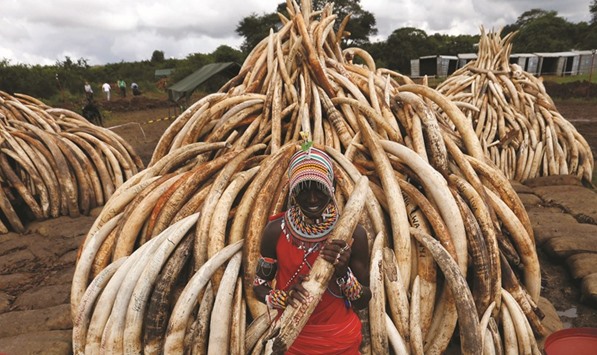Kenya wants a ban on all sales of elephant ivory, its president told other African leaders and conservationists at discussions yesterday on how to save the continent’s embattled elephant and rhino populations.
From 1.2mn in the 1970s, the number of elephants roaming Africa has plunged to around 400,000.
Poaching for ivory killed 30,000 elephants a year from 2010 to 2012.
The future for rhinos, now numbering less than 30,000, is even bleaker unless poaching is checked.
“The future of the African elephant and rhino is far from secure so long as demand for their products continues to exist,” said President Uhuru Kenyatta, adding any sale, even in legal domestic markets, increased risks to the animals.
Kenya would seek a “total ban on the trade in elephant ivory” at a meeting on the Convention on International Trade in Endangered Species of Wild Fauna and Flora (CITES) in South Africa later this year, the president told the “Giants Club” summit.
Signalling its commitment, Kenya will burn 105 tonnes of seized ivory today.
The CITES approved a ban on commercial trade in African elephant ivory in 1989, but since then has permitted one-off sales. Conservationists want more prosecutions of poachers, the slashing of demand for ivory and rhino horn, most of which is in east Asia, and deeper co-operation across borders to fight poachers.
“It has taken a crisis to get us to better collaboration, and the successes are still very fragile,” said Iain Douglas-Hamilton, chief executive of the charity Save the Elephants.
In Kenya, 93 elephants were killed in 2015, down from 384 in 2012.
But conservationists say the East African nation remains a transit point for poached wildlife parts from other countries.
Leaders from Uganda and Gabon attended the summit to outline efforts to curb illegal hunting by poachers, who in some regions have used belt-fed machineguns to mow down animals.
Ugandan President Yoweri Museveni said that population pressure threatened animal habitats.
“The strategic challenge is to make the African population shift from low-technology agriculture to industry and services,” he said.
“Political will, that is the key ingredient,” Max Graham, the founder of charity Space for Giants, told a news conference at Kenya’s Ol Pejeta Conservancy ahead of the summit, which was held at a hotel nearby on the slopes of Mount Kenya.
Ol Pejeta has been protecting and slowly rebuilding Kenya’s rhino numbers.
Airborne rapid reaction rangers, a helicopter with night vision and better intelligence in the local community have helped.
But it seems too late for the north white rhino. Just three individuals of the species remain, guarded 24 hours a day at the Ol Pejeta site.
Scientists are racing against time to work out artificial reproductive techniques for the ageing animals.
Ol Pejeta is also home to many more black rhino.
China and the United States, two of the biggest ivory markets, announced plans last year to enact almost complete bans on imports and exports.
The ivory price in Hong Kong, a major trade route to China which also announced plans for a sales ban, has fallen to about $380 per kg from $1,500 in 2014, Peter Knights, executive director of WildAid, told Reuters.
Others said that the ivory price elsewhere remained higher.
“It is never fast enough, but it is definitely heading in the right direction,” Knights said.
Swaziland to ask UN body to sell its rhino horn stockpile
Swaziland has submitted a proposal to the Convention on International Trade in Endangered Species (CITES) to sell its rhino horn stocks to help pay for anti-poaching efforts, according to a copy of the submission obtained by Reuters.
Swaziland’s bid is a surprise after neighbouring South Africa, which will host the next major CITES conference in September, decided not to push to loosen a global ban in trade in rhino horn in force since 1977.
It also comes against the backdrop of a surge in poaching of rhinos for the animal’s horn, which is coveted in Vietnam and other Asian countries as an ingredient in traditional medicine.
A record 1,305 rhinos were illegally killed in Africa last year.
African leaders and environmentalists were meeting in Kenya yesterday to discuss ways of combatting elephant and rhino poaching.
For Swaziland’s proposal to succeed, it will need to get two-thirds of the countries attending the September meeting to support it – a difficult task as the issue is a red-button one that sharply divides conservationists.
Opponents of opening up the trade argue it could lead to more poaching by criminal gangs seeking to launder “dirty” horns in clean markets.
Supporters of a regulated trade say it could stem poaching by bringing licit supplies directly to the source of demand.
Currently that can only be met illegally.
The Swazi proposal seeks “a limited and regulated trade in white rhino horn which has been collected in the past from natural deaths, or recovered from poached Swazi rhino”.
It also wants to sell horn “harvested in a non-lethal way from a limited number of white rhino in the future in Swaziland”.
Rhino horn grows back after it is cut off and the animals can be darted for such operations.

A Maasai tribesman holds an elephant tusk, part of an estimated 105 tonnes of ivory to be set ablaze today, at Nairobi National Park.


